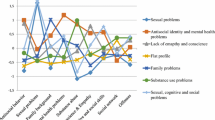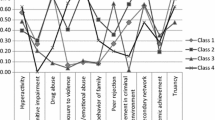Abstract
Purpose
High-risk mentally disordered offenders present a diverse array of clinical characteristics. To contain and effectively treat this heterogeneous population requires a full understanding of the group’s clinical profile. This study aimed to identify and validate clusters of clinically coherent profiles within one high-risk mentally disordered population in the UK.
Methods
Latent class analysis (a statistical technique to identify clustering of variance from a set of categorical variables) was applied to 174 cases using clinical diagnostic information to identify the most parsimonious model of best fit. Validity analyses were performed.
Results
Three identified classes were a ‘delinquent’ group (n = 119) characterised by poor educational history, strong criminal careers and high recidivism risk; a ‘primary psychopathy’ group (n = 38) characterised by good educational profiles and homicide offences and an ‘expressive psychopathy’ group (n = 17) presenting the lowest risk and characterised by more special educational needs and sexual offences.
Conclusions
Individuals classed as high-risk mentally disordered offenders can be loosely segregated into three discrete subtypes: ‘delinquent’, ‘psychopathic’ or ‘expressive psychopathic’, respectively. These groups represent different levels of risk to society and reflect differing treatment needs.

Similar content being viewed by others

References
Tyrer P, Cooper S, Rutter D, Seivewright H, Duggan C, Maden T et al (2009) The assessment of dangerous and severe personality disorder: lessons from a randomised controlled trial linked to qualitative analysis. Forensic Psychiatry Psychol 20:132–146
Ullrich S, Yang M, Coid J (2010) Dangerous and severe personality disorder: an investigation of the construct. Int J Law Psychiatry 33(2):84–88
Kirkpatrick T, Draycott S, Freestone M, Cooper S, Twiselton K, Watson N, Evans J, Hawes V, Jones L, Moore C, Andrews K, Maden T (2010) A descriptive evaluation of patients and prisoners assessed for dangerous and severe personality disorder. J Forensic Psychiatry Psychol 21:264–282
Sheldon KL, Tetley AC et al (2013) Are they different? A comparison of risk in dangerous and severe personality disordered and personality disordered hospitalized populations. Psychol Crime Law 19:67–83
Howard R, Khalifa N et al (2012) Are patients deemed dangerous and severely personality disordered different from other personality disordered patients detained in forensic settings? Criminal Behav Mental Health 22(1):65–78
Freestone M, Taylor C et al (2012) Assessments and admissions during the first 6 years of a UK medium secure DSPD service. Criminal Behav Mental Health 22(2):91–107
Department of Health (2008) Dangerous and severe personality disorder (DSPD) high secure services for men: planning and delivery guide. Ministry of Justice
Barrett B, Byford S, Seivewright H, Cooper S, Duggan C, Tyrer P (2009) The assessment of dangerous and severe personality disorder: service use, cost and consequences. J Forensic Psychiatry Psychol 20:120–131
Burns T, Fahy T, Fitzpatrick R, Rogers R, Sinclair J, Fazel S, Fazel J (2011) Dangerous severe personality disorder (DSPD) patients: characteristics and comparison with other high risk offenders. Int J Forensic Mental Health 10:1–10
Loranger AW, Sartorius N, Andreoli A, Berger P, Buchheim P, Channabasavanna SM, Coid B, Dahl A, Diekstra RFW, Ferguson B, Jacobsberg LB, Mombour W, Pull C, Ono Y, Regier DA (1994) The international personality disorder examination. Arch Gen Psychiatry 51:215–224
Hare RD (1991) The psychopathy checklist revised. Multi-Health Systems, Toronto
Harpur TJ, Hackstian AR, Hare RD (1988) Factor structure of the psychopathy checklist. J Consult Clin Psychol 56:741–747
Wechsler D (1999) WASI manual. Psychological Corporation, San Antonio
McGuire-Snieckus R, McCabe R, Catty J, Priebe S (2007) A new scale to assess the therapeutic relationship in community mental health care: STAR. Psychol Med 37:85–95
D’Zurilla TJ et al (2000) Social problem solving inventory revised. Multi-Health Systems Inc, North Tonawanda
D’Zurilla TJ, Nezu AM (1990) Development and preliminary evaluation of the social problem-solving inventory. Psychol Assess 2:156–163
Wong S, Gordon A (2000) Violence risk scale. Regional Psychiatric Centre, Saskatoon
Wong S, Gordon A (2006) The validity and reliability of the violence risk scale: a treatment-friendly violence risk assessment tool. Psychol Public Policy Law 12:279–309
Webster CD, Douglas KS, Eaves D, Hart SD (1997) HCR-20: assessing risk for violence (version 2). Simon Fraser University, Vancouver
Douglas KS, Webster CD (1999) The HCR-20 violence risk assessment scheme: concurrent validity in a sample of incarcerated offenders. Criminal Justice Behav 26:1–12
Wareham J, Dembo R, Poythress NG, Childs K, Schmeidler J (2009) A latent class factor approach to identifying subtypes of juvenile diversion youths based on psychopathic features. Behav Sci Law 27:71–95
Swogger MT, Kosson DS (2007) Identifying subtypes of criminal psychopaths: a replication and extension. Criminal Justice Behav 34:953
Vermunt JK, Magidson J (2003) Latent gold 3.0 user’s guide. Statistical Innovations Inc, Belmont
Karpman B (1948) The myth of the psychopathic personality. Am J Psychiatry 104:523–534
Lykken DT (1995) The antisocial personalities. Lawrence Erlbaum Associates, Mahwah
Blackburn R (1986) Patterns of personality deviation among violent offenders. Br J Criminol 26:254–269
Blackburn R, Coid J (1999) Empirical clusters of DSM-III personality disorders in violent offenders. J Pers Disord 13:18–34
Blackburn R, Logan C, Donnelly JP, Renwick SJ (2008) Identifying psychopathic subtypes: combining an empirical personality classification of offenders with the Psychopathy checklist-revised. J Pers Disord 22:604–622
Skeem JL, Poythress N, Edens JF, Lilienfield SO, Cale EM (2003) Psychopathic personality or personalities? Exploring potential variants of psychopathy and their implications for risk assessment. Aggress Violent Behav 8:513–546
Blackburn R (2009) Subtypes of psychopath. In: McMurran M, Howard R (eds) Personality, personality disorder and violence. Wiley-Blackwell, London
Alterman AI, McDermott PA, Cacciola JS et al (1998) A typology of antisociality in methadone patients. J Abnorm Psychol 107:412–422
Duggan C (2011) Dangerous and severe personality disorder. Br J Psychiatry 198:431–433
Burns T, Yiend J, Fahy T, Fitzpatrick R, Rogers R, Fazel S, Sinclair J (2011) Treatments for dangerous severe personality disorder (DSPD). J Forensic Psychiatry Psychol. doi:10.1080/14789949.2011.577439
Sinclair J, Willmott L, Fitzpatrick R, Burns T, Yiend J (2012) Patients’ experience of dangerous and severe personality disorder (DSPD) services: a qualitative interview study. Br J Psychiatry 200:252–253
Blackburn R (1975) An empirical classification of psychopathic personality. Br J Psychiatry 127:456–460
Blackburn R (2007) Personality disorder and psychopathy: conceptual and empirical integration. Psychol Crime Law 13:7–18
Chambers JC, Yiend J, Burns T et al (2009) Outcome measures used in forensic mental health research: a structured review. Criminal Behav Mental Health 19:9–27
Yiend J, Chambers JC, Burns T, Doll H, Seena Fazel S, Kaur A, Sutton L, Fitzpatrick R (2011) Outcome measurement in forensic mental health research: an evaluation. Psychol Crime Law 17:277–292
Acknowledgments
This investigation was funded by the Ministry of Justice and Department of Health through the DSPD programme. We would also like to thank all the clinical staff who made our visits to these high security destinations run so smoothly; teams were run by Professor Tony Maden, Ms Julie Luther, Mr Lawrence Jones, Dr Gopi Krishnan and Dr. Jacqui Saradjian.
Conflict of interest
We declare that we have no conflicts of interest. All procedures involved in the conduct of this research were approved by a UK ethics committee and have therefore been performed in accordance with the ethical standards laid down in the 1964 Declaration of Helsinki and its later amendments.
Author information
Authors and Affiliations
Consortia
Corresponding author
Additional information
The members of the IDEA group are listed in Appendix.
Appendix
Appendix
The IDEA group comprises (in alphabetical order): Tom Burns, Martin Clarke, Helen Doll, Wendy Dyer, Zoe Elkington, Tom Fahy, Seena Fazel, Ray Fitzpatrick, Alison Foster, Lindsey Johnston, Cara Jones, Louise Linsell, Helen McKinnon, Jacinta Prendergast, Robert Rogers, Julia Sinclair, Lucy Willmott and Jenny Yiend.
Rights and permissions
About this article
Cite this article
Yiend, J., Freestone, M., Vazquez-Montes, M. et al. The clinical profile of high-risk mentally disordered offenders. Soc Psychiatry Psychiatr Epidemiol 48, 1169–1176 (2013). https://doi.org/10.1007/s00127-013-0696-9
Received:
Accepted:
Published:
Issue Date:
DOI: https://doi.org/10.1007/s00127-013-0696-9



